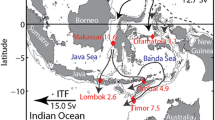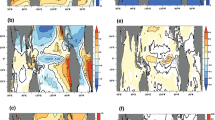Abstract
A significant fraction of the inter-annual variability in the Nile River flow is shaped by El Niño Southern Oscillation (ENSO). Here, we investigate a similar role for the Indian Ocean (IO) sea surface temperature (SST) in shaping the inter-annual variability of the Nile River flow. Using observations of global SST distribution and river flow in addition to atmospheric general circulation model sensitivity experiments, we show that North and Middle IO SSTs play a significant intermediate role in the teleconnection between ENSO and the Nile flow. Applying partial coherency analyses, we demonstrate that the connection between North and Middle IO SSTs and Nile flow is strongly coupled to ENSO. During El Niño events, SST in the North and Middle IO increases in response to the warming in the Tropical Eastern Pacific Ocean and forces a Gill-type circulation with enhanced westerly low-level flow over East Africa and the Western IO. This anomalous low-level flow enhances the low-level flux of air and moisture away from the Upper Blue Nile (UBN) basin resulting in reduction of rainfall and river flow. SSTs in the South IO also play a significant role in shaping the variability of the Nile flow that is independent from ENSO. A warming over the South IO, generates a cyclonic flow in the boundary layer, which reduces the cross-equatorial meridional transport of air and moisture towards the UBN basin, favoring a reduction in rainfall and river flow. This independence between the roles of ENSO and South IO SSTs allows for development of new combined indices of SSTs to explain the inter-annual variability of the Nile flow. The proposed teleconnections have important implications regarding mechanisms that shape the regional impacts of climate change over the Nile basin.















Similar content being viewed by others
References
Amarasekera KN, Lee RF, Williams ER, Eltahir EA (1996) B: ENSO and the natural variability in the flow of tropical rivers. J Hydrol 200:24–39
Beltrando G, Camberlin P (1993) Interannual variability of rainfall in Eastern Horn of Africa and indicators of atmospheric circulation. Int J Climatol 13:533–546
Black E, Slingo J, Sperber KR (2003) An observational study of the relationship between excessively strong short rains in coastal East Africa and Indian Ocean SST. Mon Weather Rev 31:74–94
Camberlin P (1995) June–September rainfall in North-Eastern Africa and atmospheric signals over the tropics: a zonal perspective. Int J Climatol 15:773–783
Camberlin Pierre (1997) Rainfall anomalies in the source region of the Nile and their connection with the Indian summer monsoon. J Clim 10:1380–1392
Cole JE et al (2000) Tropical pacific forcing of decadal SST variability in the western Indian Ocean over the past two centuries. Science 287(5453):617–619
Conway D, Hulme M (1993) Recent fluctuations in precipitation and runoff over the Nile sub-basins and their impact on main Nile discharge. Clim Change 25:127–151
Dee DP et al (2011) The ERA-Interim reanalysis: configuration and performance of the data assimilation system. Q J R Meteorol Soc 137:553–597
ElDaw A, Salas JD, Garcia LA (2003) Long-range forecasting of the Nile River flows using climate forcing. J Appl Meteorol 42:890–904
ElShamy ME (2009) Impacts of climate change on Blue Nile flows using bias corrected GCM scenarios. Hydrol Earth Syst Sci 13:551–565
Eltahir EAB (1996) ElNino and the natural variability in the flow of the Nile River. Water Resour Res 32(1):131–137
Giannini A, Saravanan R, Chang P (2003) Oceanic forcing of Sahel rainfall on interannual to interdecadal time scales. Science 302:1027–1030
Hastenrath Stefan, Polzin Dierk, Mutai Charles (2011) Circulation mechanisms of Kenya rainfall anomalies. J Clim 24:404–412
IPCC (2007) The physical science basis. Contribution of working group I to the fourth assessment report of the intergovernmental panel on climate change. In: Solomon S, Qin D, Manning M, Chen Z, Marquis M, Averyt KB, Tignor M, Miller HL (eds) Climate change 2007. Cambridge University Press, Cambridge, United Kingdom and New York, NY, USA
Jobson JD (1991) Applied multivariate data analysis. Volume I: regression and experimental design. Springer, New York, pp 182–185
Johns TC et al (2006) The new hadley centre climate model (HadGEM1): evaluation of coupled simulations. J Clim 19:1327–1353
Ju J, Slingo JM (1995) The Asian summer monsoon and ENSO. Q J R Meteorol Soc 121:1133–1168
Kalnay E et al (1996) The NCEP/NCAR 40-year reanalysis project. Bull Am Meteorol Soc 77:437–471
Kawamura R (1998) A possible mechanism of the Asian summer monsoon-ENSO coupling. J Meteorol Soc Jpn 76:1009–1027
Martin GM, Ringer MA, Pope VD, Jones A, Dearden C, Hinton TJ (2006) The physical properties of the atmosphere in the New Hadley Centre Global Environmental Model (HadGEM1). Part I: model description and global climatology. J Clim 19(7):1274–1301. doi:10.1175/JCLI3636.1
Mitchell TD, Jones PD (2005) An improved method of constructing a database of monthly climate observations and associated high-resolution grids. Int J Climatol 25:693–712
Mutai Charles C, Neil Ward M (2000) East African rainfall and the tropical circulation/convection on intraseasonal to interannual timescales. J Clim 13:3915–3939
Nicholson Sharon E (1997) An analysis of the ENSO signal in the tropical Atlantic and western Indian Oceans. Int J Climatol 17(4):345–375
Pohl B, Camberlin P (2006) Influence of the Madden–Julian oscillation on East African rainfall. Part I: intraseasonal variability and regional dependency. Q J R Meteorol Soc 132:2521–2539
Rayner NA, Parker DE, Horton EB, Folland CK, Alexander LV, Rowell DP, Kent EC, Kaplan A (2003) Global analyses of sea surface temperature, sea ice, and night marine air temperature since the late nineteenth century. J Geophys Res 108(D14):4407
Ringer MA, Martin GM, Greeves CZ, Hinton TJ, James PM, Pope VD, Scaife AA, Stratton RA, Inness PM, Slingo JM, Yang GY (2006) The physical properties of the atmosphere in the New Hadley Centre Global Environmental Model (HadGEM1). Part II: aspects of variability and regional. J Clim 19:1302–1326
Shukla J, Wallace JM (1983) Numerical simulation of the atmospheric response to equatorial Pacific sea surface temperature anomalies. J Atmos Sci 40:1613–1630
Siam SM, Demory ME, Eltahir EAB Hydrological cycles over the Congo and upper Blue Nile basins: evaluation of general circulation models simulations and reanalysis data products. J Clim. doi:10.1175/JCLI-D-12-00404.1
Soman MK, Slingo J (1997) Sensitivity of the Asian summer monsoon to aspects of sea-surface-temperature anomalies in the tropical Pacific Ocean. Q J R Meteorol Soc 123:309–336
Taylor KE, Williamson D, Zwiers F (2000) The sea surface temperature and sea-ice concentration boundary conditions for AMIP II simulations. Technical Report 60, PCMDI
Tomczak M, Godfrey JS (1995) Regional oceanography: an introduction. Pregamon, London
Trenberth KE (1997) The definition of El Niño. Bull Am Meteorol Soc 78:2771–2777
Uppala SM et al (2005) The ERA-40 re-analysis. Q J R Meteorol Soc 131:2961–3012
Vörösmarty CJ, Fekete B, Tucker BA (1998) River discharge database, Version 1.1 (RivDIS v 1.0 supplement). Available through the institute for the study of earth, oceans and space University of New Hampshire, Durham NH (USA)
Wang G, Eltahir EAB (1999) Use of ENSO information in medium and long range forecasting of the Nile floods. J Clim 12:1726–1737
Yang JL, Liu QY, Xie SP et al (2007) Impact of the Indian Ocean SST basin mode on the Asian summer monsoon. Geophys Res Lett 34:L02708. doi:10.1029/2006GL028571
Author information
Authors and Affiliations
Corresponding author
Rights and permissions
About this article
Cite this article
Siam, M.S., Wang, G., Demory, ME. et al. Role of the Indian Ocean sea surface temperature in shaping the natural variability in the flow of Nile River. Clim Dyn 43, 1011–1023 (2014). https://doi.org/10.1007/s00382-014-2132-6
Received:
Accepted:
Published:
Issue Date:
DOI: https://doi.org/10.1007/s00382-014-2132-6




